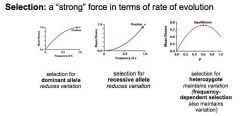![]()
![]()
![]()
Use LEFT and RIGHT arrow keys to navigate between flashcards;
Use UP and DOWN arrow keys to flip the card;
H to show hint;
A reads text to speech;
31 Cards in this Set
- Front
- Back
- 3rd side (hint)
|
What are the postulates of natural selection?
|
Variability, Heritability, Variation in reproductive success, Survival/repro is non-random
|
|
|
|
What did the pea aphid and desert locust examples illustrate?
|
Evironmental conditions inducing variability in phenotypes that IS NOT heritable.
|
|
|
|
What does a heritability score of 1 mean?
|
A strong parent-offspring correlation. What does it come from?
|
The slope of the regression line is 1. Mean parental value trait of parent (x axis) against mean value of phenotype in all of the parents' offspring.
|
|
|
Chromosome definition
|
an organized structure of DNA and protein found in cells. It is a single piece of coiled DNA containing many genes, regulatory elements and other nucleotide sequences. Chromosomes also contain DNA-bound proteins, which serve to package the DNA and control its functions.
|
|
|
|
allele definition
|
one of two or more forms of a gene or a genetic locus;
Alternate form of a gene |
|
|
|
genome definition
|
the entirety of an organism's hereditary information
-made of DNA or RNA |
|
|
|
Transcription
|
the process of creating a complementary RNA copy of a sequence of DNA
|
|
|
|
translation
|
the third stage of protein biosynthesis (part of the overall process of gene expression). In translation, messenger RNA (mRNA) produced by transcription is decoded by the ribosome to produce a specific amino acid chain, or polypeptide, that will later fold into an active protein.
|
|
|
|
genetic code
|
The genetic code is the set of rules by which information encoded in genetic material (DNA or mRNA sequences) is translated into proteins (amino acid sequences) by living cells.
|
|
|
|
haploid number
|
The haploid number (n) is the number of chromosomes in a gamete. A somatic cell has twice that many chromosomes (2n).
|
|
|
|
purine
|
A and G
|
|
|
|
pyrimidine
|
C and T
|
|
|
|
polypeptide
|
a long, continuous, and unbranched peptide. Peptides are...
|
short polymers of amino acid monomers linked by peptide bonds. They are distinguished from proteins on the basis of size,
|
|
|
What are sources of genetic variation?
|
A. Mutation
b. Independent assortment c. Recombination |
|
|
|
Transition versus transversion
|
Types of mutations
-Transitions happen more commonly; less disruptive to DNA replication/protein (A to G; C to T) -Transversions are a purine to pyrimidine change (A to C; G to T) |
this actually isn't as intuitive as I thought. make sure you know.
|
|
|
Common cause of variability at microsatellites?
|
Replication slippage
|
|
|
|
Large scale mutation examples
|
-Unequal crossing-over (non-homologous recombination
-Inversions; double stranded breaks -Translocations among chromosomes |
|
|
|
Hardy-Weinberg principle
|
-Null model
-What to expect if evolution isn't happening -No change in allele frequencies between generations -HW proportions are restored in a single generation of random mating |
|
|
|
Assumptions of HW principle
|
-No selection
-No migration -No mutation -Large pop size -Random mating (panmixia) |
|
|
|
What are the four evolutionary "forces"?
|
Selection, drift, mutation, migration
|
|
|
|
Relative fitness
|
"w"
Fitness of genotypes relative to a reference genotype 1 = maximal fitness |
|
|
|
Selection coefficient
|
"s"
s = 1 - w Also represents fitness of genotypes. When no selection against a genotype, w = ___ and s=_____. When genotype is lethal, w=____ and s=_____ |
1, 0
0,1 |
|
|
When selection is for recessive and against a dominant allele...
|
Evolution is slow to remove A at first b/c a is hiding in heterozygotes. Removal of A accelerates towards the end.
|
|
|
|
When selection is for a dominant and against a recessive allele...
|
a will be removed quickly at first, then slower toward the end. This is because some a alleles are hiding in heterozygotes.
|
|
|
|
Selection favoring heterozygotes...
|
-is termed overdominance
-maintains diversity because one allele will never be fixed (none lost if heteros are favored) -Pop will always evolve to a stable equilibrium maintaining both alleles |
|
|
|
Freq-dependent selection...
|
-maintains diversity in a population
-e.g. rare prey morph undetected by predator; higher fitness until it becomes the common morph; predator learns this new common morph which becomes selected against (decreasing fitness); original common morph re-emerges, driving pop back to equilibrium |
|
|
|
Mutation...
|
-Is weak (slow) evo force
-Can change allele freqs, but over long periods of time -Does not typically change HWP much -Is the ultimate source of genetic variation |
|
|
|
Hardy-Weinberg take-homes
|
1. It's possible to change gt freqs without change in allele freqs
2. HW equil does NOT mean p=0.5 and q-0.5 3. Deviation from HWP is a weak test of evolution -Lack of deviation doesn't necessarily mean no evolution -Conversely, if there is deviation, good chance that something interesting is going on. 4. HWP proportions will be restored in a single generation of random mating! So it can be used to calculate next generation gt freqs after selection, migration, etc. |
|
|
|
Selection take-homes
|

|
|
|
|
Mutation take-homes
|
A "weak" force in terms of rate of evolution, but...
|
the ULTIMATE source of variation: without new mutations, evo can eventually grind to a halt. Lack of variation = no evolution.
|
|
|
Migration (aka "________") is...
|
"gene flow"
Movement of alleles between populations |
|

